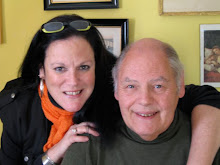




We've had a forecast of snow for the last two days but all we saw today was heavy rain until about an hour ago when they sky opened up with snowflakes the size of ravioli. P spent the earlier part of the day trimming the acacia trees on the road outside of our house and that's what we're burning right now. The wood is damp but the smaller branches are burning and throwing some heat. My center of operation is the kitchen table so it's pretty cozy now with the fire right next to me.
P's operation central is below..nella cantina. The cellar is a very handy spot for doing just about everything. Silly me, I thought when I settled in here four years ago it would be MY operation central. Afterall, P said, "It's the coolest spot in the summer and the warmest in the winter." I had all kinds of visions of dolling it up with a desk and chair, a flea market rug,oriental perhaps and without the fleas for the floor, a bookcase for my cookbooks, novels, art books and files, a lamp with a green glass shade. Maybe a little Puccini in the background for inspiration while I try to figure out my life and what's for lunch.
HAH! Once I saw what really went on down there I knew my little hide-a-way was a dream. What most people do with an attic we do with the cellar, plus more. Right now, P is down there chopping the branches that he pruned today. The acacia wood is very hard and loaded with big, ugly thorns so he has to be careful. In the springtime these trees are dripping with the most fragrant blossoms. We pick the blossoms and after checking for bugs, etc. we drag them through a simple batter and fry them. Then dust them with sugar while they're still hot. Like eating a delicate, sweet, perfume fritter.
The cellar is where the furnace is, the freezer, the summer clothes, the tools, all the wood for the fireplace, the overflow of my books, the tomatoes and peaches we put up in the summer, P's homemade limoncello, marmellate, the demijohn of vino, jars, bottles, Nativity projects. Plus everything that P won't throw out because he just might need it. He has built shelves and ripped them out to make them bigger so they can hold more stuff. There's even a little mattress down there for nights that get too hot upstairs. I tried sleeping down there once and it was okay until about three AM when I heard something buggy and grabbed the flashlight and saw a big round black bug crawling along the edge of the pillow case. Never saw one like it before. P's not so faint of heart and can manage the whole night down there.
I also like to think of the cellar as a time out room for grown-ups. We're in pretty close quarters here and when things get the other kind of "hot", the cellar is a little refuge. It's very comfortable and can be very entertaining. I think it was my first summer here that I told P that I wanted a purple cellar door. I've seen a lot of purple doors and really don't know their significance. If anybody knows would you please drop me a line? Anyway, I wanted one and I was a little surprised when he said okay. You don't see many purple doors around here. The biggest profusion of purple in these parts is when the Fiorentina fans come out for a soccer match. So, my beloved P, who has absolutely no interest in soccer and has never watched a whole match in his life, mixed the three cans of paint to get just the right color I wanted. And during that incredibly hot summer the door went from red to purple. While P was sweating out this labor of love, our neighbor Franco walked by. He stopped, watched for a minute and remarked,"Formichi, I had no idea you were such a Fiorentina fan!"


















